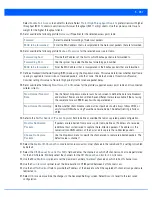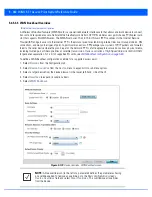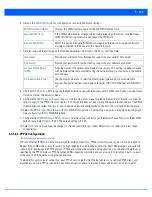
5 - 273
10. Either select
Add
to create a new L2TPv3 configuration,
Edit
to modify an existing tunnel configuration or
Delete
to remove
a tunnel from those available to this profile.
Figure 5-176
Device Overrides - Network - L2TPv3 screen, Add L2TPv3 Tunnel Configuration
11. If creating a new tunnel configuration, assign it a 31 character maximum
Name
.
12. Refer to the
Session
table to review the configurations of the peers available for tunnel connection.
13. Select
+ Add Row
to populate the table with configurable session parameters for this tunnel configuration.
14. Define the following
Session
parameters:
Critical Resource
Specifies the critical resource that should exist for a tunnel between two peers to be
created and maintained. Critical resources are device IP addresses or interface
destinations interpreted as critical to the health of the network. Critical resources allow
for the continuous monitoring of these defined addresses. A critical resource, if not
available, can result in the network suffering performance degradation. A critical resource
can be a gateway, AAA server, WAN interface or any hardware or service on which the
stability of the network depends. Critical resources are pinged regularly. If there is a
connectivity issue, an event is generated stating a critical resource is unavailable.
Peer IP Address
Displays the IP address of the device at the other end of the L2TPv3 tunnel.
Host Name
Specifies the administrator assigned hostname of the tunnel.
Name
Enter a 31 character maximum session name. There is no idle timeout for a tunnel. A
tunnel is not usable without a session and a subsequent session name.The tunnel is
closed when the last session tunnel session is closed.
Pseudowire ID
Define a psuedowire ID for this session. A pseudowire is an emulation of a layer 2 point-
to-point connection over a
packet-switching network
(PSN). A pseudowire was developed
out of the necessity to encapsulate and tunnel layer 2 protocols across a layer 3 network.
Traffic Source Type
Lists the type of traffic tunnelled in this session (VLAN etc.).
Summary of Contents for WiNG 5.7.1
Page 1: ...WiNG 5 7 1 ACCESS POINT SYSTEM REFERENCE GUIDE ...
Page 2: ......
Page 3: ...WING 5 7 1 ACCESS POINT SYSTEM REFERENCE GUIDE MN001977A01 Revision A April 2015 ...
Page 4: ...ii WiNG 5 7 1 Access Point System Reference Guide ...
Page 24: ...1 4 WiNG 5 7 1 Access Point System Reference Guide ...
Page 36: ...2 12 WiNG 5 7 1 Access Point System Reference Guide ...
Page 72: ...3 36 WiNG 5 7 1 Access Point System Reference Guide ...
Page 470: ...5 386 WiNG 5 7 1 Access Point System Reference Guide ...
Page 472: ...6 2 WiNG 5 7 1 Access Point System Reference Guide Figure 6 1 Configuration Wireless menu ...
Page 624: ...7 46 WiNG 5 7 1 Access Point System Reference Guide ...
Page 724: ...9 56 WiNG 5 7 1 Access Point System Reference Guide ...
Page 783: ...12 35 Figure 12 46 Device Summary screen 4 Click File Management ...
Page 816: ...12 68 WiNG 5 7 1 Access Point System Reference Guide ...
Page 1006: ...13 190 WiNG 5 7 1 Access Point System Reference Guide ...
Page 1026: ...14 20 WiNG 5 7 1 Access Point System Reference Guide ...
Page 1028: ...A 2 WiNG 5 7 1 Access Point System Reference Guide ...
Page 1089: ......
Page 1090: ...MN001977A01 Revision A April 2015 ...






























